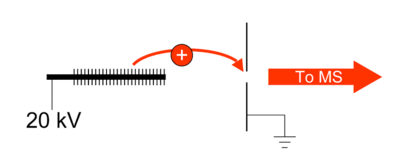Field desorption

Field desorption (FD) is a method of ion formation used in mass spectrometry in which a high-potential electric field is applied to an emitter with a sharp surface, such as a razor blade, or more commonly, a filament from which tiny "whiskers" have formed.[1][2] This results in a high electric field which can result in ionization of gaseous molecules of the analyte. Mass spectra produced by FD have little or no fragmentation because FD is a soft ionization method. They are dominated by molecular radical cations M+. and less often, protonated molecules . The technique was first reported by Beckey in 1969.[3]
Mechanism
In FD, the analyte is applied as a thin film directly to the emitter, or small crystals of solid materials are placed onto the emitter. Slow heating of the emitter then begins, by passing a high current through the emitter, which is maintained at a high potential (e.g. 5 kilovolts). As heating of the emitter continues, low-vapor-pressure materials get desorbed and ionized by alkali metal cation attachment.
Applications
Many earlier applications of FD to analysis of polar and nonvolatile analytes such as polymers and biological molecules have largely been supplanted by newer ionization techniques. However, FD remains one of the only ionization techniques that can produce simple mass spectra with molecular information from hydrocarbons and other particular analytes. The most commonly encountered application of FD at the present time is the analysis of complex mixtures of hydrocarbons such as that found in petroleum fractions.
Liquid injection
The recently developed liquid injection FD ionization (LIFDI) [4] technique "presents a major breakthrough for FD-MS of reactive analytes":[5] Transition metal complexes are neutral and due to their reactivity, do not undergo protonation or ion attachment. They benefit from both: the soft FD ionization and the safe and simple LIFDI transfer of air/moisture sensitive analyte solution. This transfer occurs from the Schlenk flask to the FD emitter in the ion source through a fused silica capillary without breaking the vacuum.
References
- ↑ IUPAC, Compendium of Chemical Terminology, 2nd ed. (the "Gold Book") (1997). Online corrected version: (2006–) "Field desorption".
- ↑ Röllgen, F. W. (1983). "Principles of Field Desorption Mass Spectrometry (Review)". 25: 2–13. doi:10.1007/978-3-642-87148-1_1. ISSN 0172-6218.
- ↑ Beckey H.D. Field ionization mass spectrometry. Research/Development, 1969, 20(11), 26
- ↑ Linden, H. (2004). "Liquid injection field desorption ionization: a new tool for soft ionization of samples including air sensitive catalysts and non-polar hydrocarbons". European Journal of Mass Spectrometry. 10 (1): 459. doi:10.1255/ejms.655. ISSN 1356-1049.
- ↑ Jürgen H. Gross (14 February 2011). Mass Spectrometry: A Textbook. Springer Science & Business Media. p. 362. ISBN 978-3-642-10709-2.
Further reading
- Beckey, H D (1979). "Experimental techniques in field ionisation and field desorption mass spectrometry". Journal of Physics E: Scientific Instruments. 12 (2): 72–83. doi:10.1088/0022-3735/12/2/002. ISSN 0022-3735.
- Alexandrov, M. L.; L. N. Gall; N. V. Krasnov; V. I. Nikolaev; V. A. Pavlenko; V. A. Shkurov (1984). Экстракция ионов из растворов при атмосферном давлении - Метод масс-спектрометрического анализа биоорганических веществ [Extraction of ions from solutions at atmospheric pressure - A method for mass spectrometric analysis of bioorganic substances]. Doklady Akademii Nauk SSSR (in Russian). 277 (2): 379–383.
- Prókai, László (1990). Field desorption Mass Spectrometry. New York: M. Dekker. ISBN 0-8247-8303-4.